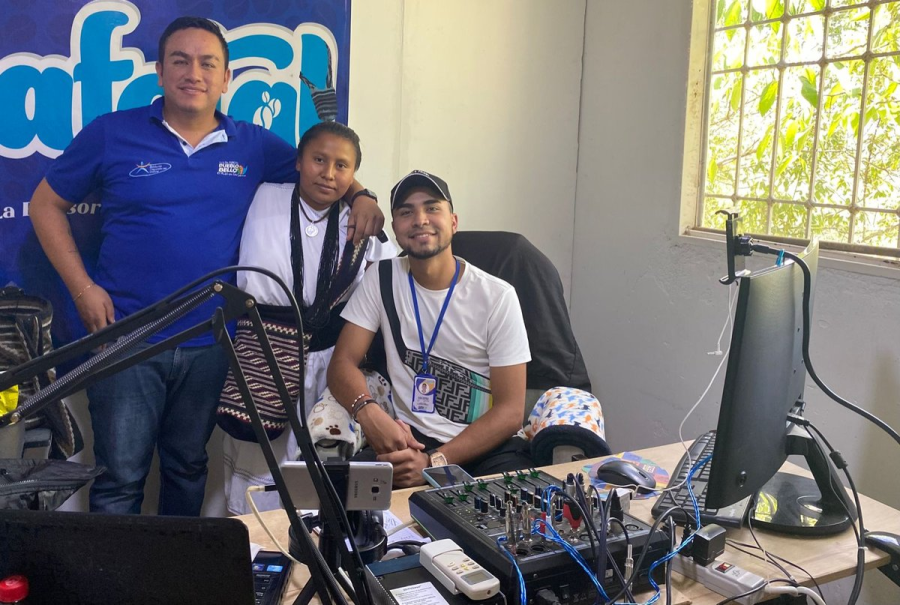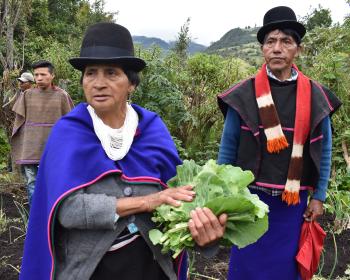Nicaragua's Miskito Indians are again front page news. This time it's for two reasons and, significantly, not for a third. First, formal peace negotiations between the rebel Indian organization MISURASATA and the Sandinista government stalled in late May. Second, three days after these negotiations ended, Nicaragua's president, Daniel Ortega, announced that communities forced to move from the Rio Coco border with Honduras to the Tasba Pri resettlement camps could return home. It was this forced relocation that originally thrust the Miskitos onto the front news pages in early 1982. Both actions raise complex questions, as does a third - in the numerous articles concerning the controversial $27 million recently approved by the U.S. Congress and the approximately $25 million in private aid for Nicaraguan "contras," MISURASATA is never mentioned.
Why, after the first formal nonagression agreement was signed on April 22, did the peace negotiations become deadlocked on May 26? Why are Miskito villagers now being allowed to return to their Rio Coco homes during a period of increased border violence? They were initially relocated from their homes expressly to avoid such danger. And why, as Indian rebel groups question the government's motives regarding the Rio Coco resettlement, do their leaders refuse to join the newly formed United Nicaraguan Opposition (UNO). This umbrella organization channels economic support, which MISURASATA desperately needs, to most other opposition groups.
In the presently fluid and uncertain Central American situation, each question has sparked a variety of answers, often conflicting. The key to the Miskito situation, however, is one that leads to the issue of Indian rights. For over two years, violence on Nicaragua's Atlantic coast produced largely geopolitical interpretations because observers failed to recognize the grass-roots nature of the Indian insurgence. Both the Left and the Right rejected or chose to ignore the ethnic aspects of the problems. Ethnic issues suited neither their general interpretive framework nor their immediate practical goals. In late 1984, this changed: the Nicaraguan government declared that MISURASATA and its leader, Brooklyn Rivera, were not "contras." Nicaraguan officials now recognize a unique Indian protest, but their problems remain to be resolved.
The Peace Negotiations
Last April the Sandinistas hoped to convert the Mexico City agreement - basically a mutual cessation of offensive actions in order to provide Indian communities essential food and medical supplies and to reestablish their economic self-sufficiency - into a general cease fire. For MISURASATA, however, the Mexico City agreement was a test - the first step toward an agreement that would satisfy the Indians' basic demands and establish conditions propitious for a lasting peace.
The May Bogotá meetings therefore, were foreseen as a critical next step. MISURASATA leaders, aware that Nicaraguan villages and rebel camps followed the talks closely, were particularly concerned. Having obtained a limited cessation of violence, they feared that the Sandinistas might hesitate or refuse to continue discussing land and resource rights and autonomy, the issues MISURASATA considered most crucial for a long-term peace settlement. A recent American Friends Service Committee Report described the situation:
MISURASATA needed to progress on the fundamental issues in order to exercise leverage on the forces of Misura. MISURASATA consistently maintained that the social base of Misura (as opposed to Steadman Fagoth and his FDN allies) supports the MISURASATA position - and the fact that MISURASATA is negotiating with the government in search of solutions.
Before the two parties met in May, reports also circulated that the government would present a plan recognizing Indian rights. This would allow the talks to shift from short sessions to extended discussions needed to implement MISURASATA's demands. At the same time, however, both parties acknowledged, informally, that violations of the April accord had occurred and needed to be discussed. MISURASATA hoped to review the incidents briefly and move quickly to the broader issues.
The agenda, however, was never realized for the Sandinistas were concerned with more immediate preventive measures. They initiated the meetings with the presentation of a formal document that listed fifteen attacks, eleven of which took place during the period of the agreement. The Nicaraguans then insisted that MISURASATA explain each event before moving on to other issues. Unfortunately, as the initial session progressed, the document was released to all observers, advisors and representatives of the guarantor nations. Circulation of the document violated the assumed confidentiality of the talks and poisoned the air of the first day's meeting.
MISURASATA also had serious criticisms regarding the implementation of the April agreement but wanted to refrain from voicing them until the talks. For example, the Sandinistas accused Indian rebels of attacking vehicles carrying medical personnel to Miskito communities. MISURASATA claimed that the government failed to mention that armed soldiers were also travelling on the vehicles and that all passengers wore military uniforms. For MISURASATA, the vehicles were seen as a provocation or, even worse, an attack. Villagers also reported that medical and rood assistance was provided on a very limited scale. MISURASATA maintained that on various occasions government officials attempted to use humanitarian aid as an entrée into rebel camps where they tried to convince the leaders to enter into independent dialogue. MISURASATA perceived this as a tactic designed to weaken the Indian organization. In addition, MISURASATA argued that Sandinista military forces took advantage of the relative calm and established camps in areas where rebel activities had prevented permanent settlement earlier. MISURASATA assumed such maneuvers positioned troops for more effective future military action.
These complaints, which MISURASATA intended to lay on the negotiating table, were not discussed. Instead, the delegation responded to the Nicaraguan document with a strong counter-statement. It stressed that no cease-fire could be "expected until the government seriously considered the basic complaints that initiated the violence. It also recommended that a three-member international commission be created to: 1) monitor the peace agreement and; 2) act as mediators in subsequent sessions in order to get beyond the stalemate caused by different perceptions of the negotiations' primary basis.
The Nicaraguan government's delegation, however, insisted that international mediation was unacceptable; the problem, members argued, was internal. The Sandinistas recommended a commission made up of various groups from the Atlantic Coast. The Sandinistas also continued to press for a total cease-fire and insisted on focusing the talks on methods for its effective monitoring. MISURASATA argued that no permanent cease-fire could be successfully implemented without significant progress on basic issues.
Such differences left both sides quietly facing each other with little hope for continued dialogue. Neither group stormed out of the Bogotá sessions; MISURASATA simply departed from the silence first. Neither group, however, maintained that the talks were over. Before leaving Bogotá, Rivera requested that the Colombian government again assist in reopening the negotiations. Colombia's president, Belisario Betancur, already has responded positively to this request. Upon returning to Nicaragua, the Sandinista delegation stressed that it was still open to discussion, a position regularly reiterated by Minister of the Interior Tomas Borge. In any event, the format for future negotiations must be reconsidered. To get beyond basic differences, some form of mediation may be required. While the short 2-3 day formal meetings, which characterized the initial negotiations, were important events, they are not what is needed to hammer out details. Extended working sessions must be initiated.
Before such matters are considered, however, MISURASATA maintains that the Nicaraguan government must accept the fact that its major concern - a cease-fire - can only occur after some progress has been made toward eliminating the conditions that incited the revolt. Despite statements that a formal autonomy plan is being prepared, a preliminary draft of that document, now available, does not appear to satisfy many of the basic demands originally put forth by MISURASATA. Rather, it more closely resembles the 1982 Declaration of Principles, a government document regarded as unacceptable by rebel groups.
The Return to the Rio Coco
Although the Nicaraguan government expressed a willingness to discuss land and resource rights and to prepare an autonomy statement, it made no visible advances. Ironically, however, Indians from the Tasba Pri resettlement camps suddenly were allowed to return to their homes near the Rio Coco. The Indians' forced relocation had not been mentioned at the negotiations because the military threat, which initially prompted the move, remained. MISURASATA assumed that resettlement of the Rio Coco was a long way away. What, then, prompted the decision?
According to a report in the June 6, 1985 issue of Barricada, Tomas Borge, FSLN delegate to the Atlantic coast and head of the regional autonomy commission, "indicated that the original resettlement policy was not mistaken, given the terror and constant danger the population was facing at the time due to the raids and other military actions by the counterrevolutionary group Misura. 'Today the conditions have changed,' said Borge. 'The Miskitos have consolidated their self-defense structures and also developed greater political and national consciousness."
Indians, however, question this interpretation. Rebel Indian troops continue to occupy and maintain control over large sections of the Atlantic Coast. The calm which now exists hinges on future negotiations. On July 29, The New York Times reported that a rebel commander, resting in an Indian-held community, had indicated he was "ready to go back to fighting if Indian demands were not met. Going back to the bush is no problem for us, but it would be a problem for the Sandinistas, the commander explained. They are the ones who won't be able to use the roads or sleep safely." Even now, anyone going to the Rio Coco must pass a rebel Indian checkpoint. While the Indians are euphoric about the move, they question the motivation for the decision. The New York Times quoted Brooklyn Rivera as saying that the return "was not so much the result of generosity by the Sandinistas as of the determination of the Miskitos" (29 July 1985). This opinion was support by international aid workers now in the area.
Other observers have commented that the Indians' rapid return home also reflects their rejection of the programs associated with the Tasba Pri resettlement camps. The government's efforts to establish production cooperatives geared to a market economy, simply failed. Despite incentives such as adequate housing, medical aid, and food subsidies, the population was not persuaded to accept the collective production system designed by government planners. Official sources indicate that Tasba Pri has produced the region's highest agricultural yields, but the residents are nevertheless abandoning the settlement as quickly as possible. In order to reconstruct their homes amidst charred ruins and subsistence plots hacked from gardens overgrown with jungle, they may leave much of Tasba Pri's produce unharvested this year.
Rebel Indian leaders also suggest that the spontaneous government decision is yet another effort to obtain Indian support through independent actions which circumvent non-government organizations such as MISURASATA and diminish their authority. Such actions characterized the 1981 Agrarian Reform laws and the 1982 "Declaration of Principles" concerning land rights. Government efforts to obtain independent peace settlements with individual rebel commanders inside Nicaragua reflect a similar policy.
Such goals, however, have been frustrated. For example, Indians returning to the Rio Coco have been provided with little logistic or material support. On July 27, The New York Times reported:
The Miskitos who have returned to the river banks recognized that their immediate future would be grim. Until the crops being sown now are" harvested at the end of the year, the Miskitos must depend on the government and foreign agencies for food and other necessities.
As of late August, however, transportation, food, and tools were in very short supply.
Nonetheless, on July 29, The Washington Post reported:
Interior Minister Tomas Borge...has boasted that all 10,000 Indians in or near the Tasba Pri camps will be home by July 15. But Hazel Law, a pro-Sandinista Miskito leader, said a more realistic estimate was 15,000 Indians home by the end of September.
A New York Times report on August 22, 1985 indicates such optimism is unwarranted. One of the camp administrators claimed, "It will take months before all of the Indians now in Sumubila [one Tasba Pri settlement] have the chance to get back to the river." By mid-August, only about 2,700 had been able to make their way back to Rio Coco, many of them entirely on their own. Local officials and relief workers cited shortages of vehicles, fuel and other necessities. Fears of rebel Indian attacks also appear to have slowed the return. In any case, the resettlement, announced as a government program but haltingly fulfilled by the Sandinistas, is now largely an individual Indian initiative.
Because of military conflict which is prevalent in the zone it has not been possible to complete an exhaustive, official investigation. However, the investigations which we have been able to complete appear to corroborate the version that the death of Pantin was accidental.
The present version is that he was lying in his hammock with a pistol on top of his body and that while he was suddenly getting up the pistol fell to the ground discharging and mortally wounding him. Our investigations have not uncovered anything that questions this version which we now consider to be fundamentally true.
Regardless of how Pantin died, independent government efforts to obtain treaties are now suspect and will make continuance of such efforts difficult. As Sandinista officials pressure MISURASATA to continue negotiations within Nicaragua, Pantin's fate will also make many rebels outside Nicaragua hesitant to return.
Although a relative calm exists in many areas, renewed violence is latent. Independent government efforts to eliminate the threat have produced frustration, suspicion and fear. In what appears to have been an effort to circumvent MISURASATA, the government's resettlement plan has instead become a de facto Indian initiative. In addition, Pantin's death places further obstacles to negotiations which, up until now, have produced a limited cessation of violence - the only significant advance toward peace anywhere in the troubled region.
MISURASATA and the "Contras"
From the standpoint of the "contras," things are "looking up." Last July, the U.S. Congress approved $27 million for "humanitarian" aid. With an additional $25 million from private, uncommitted funds, the opposition will soon be well equipped, fed, and armed. Meanwhile, the recent unification of several rebel groups into the United Nicaraguan Opposition (UNO) is a tactical achievement. Strongly supported by the Reagan administration, it assures more effective and coordinated use for the recently obtained funds. Considering MISURASATA's extremely limited funds, the strains such scarcity have already put on the leadership, and their frustrated peace efforts, collaboration with UNO is tempting. But MISURASATA shows no signs of doing so, yet.
This failure to collaborate clearly separates MISURASATA and unique Indian concerns from the "contras." It should signal the Sandinistas to move quickly on the basic questions MISURASATA has put up for negoation. Last March, Rivera announced publicly that the major opposition groups now united in UNO (ARDE and the FDN) had "told us that they would never give us Indians autonomy if they were in power." Armstrong Wiggins, another Miskito leader, reiterated similar sentiments in May. Meanwhile, FDN officials have indicated that they will use part of their $27 million to aid Miskitos in Honduras in an effort to buy their support. Such efforts could weaken the authority of those now-frustrated Miskito leaders seeking a negotiated settlement with the Sandinistas. More importantly, affiliation with UNO would draw the Indians away from their central focus - land, resource rights, and autonomy - and link them to efforts to overthrow the Sandinista government. MISURASATA has always insisted that its complaints focused on specific policies and programs - or lack thereof - and not on some generalized opposition to a revolution that has declared itself in support of the poor.
Rather than link forces with UNO, MISURASATA has joined with others concerned with similar issues. This past June 21, Rivera announced the formation of ASLA, the Miskito word for unity. It has joined Misura (now represented by Wycliffe Diego rather than Steadman Fagoth, an open FDN supporter) and the already unified MISURASATA-SICC (Southern Indian Creole Community). A year ago last August, rebel Indian leaders inside" Nicaragua united to form the Internal Indian Front. ASLA, it is hoped, will link the leadership in exile and overcome attempts by both the Sandinistas and the opposition groups to divide the indigenous Atlantic Coast leadership. The group's first major project is to meet with refugees and other Nicaraguan Indians in Honduras in October. Autonomy and how the rebel groups will respond to the Nicaraguan government's autonomy statement will be discussed [see update below].
Funds for indigenous groups are sorely needed, but obtaining them through UNO would simply draw the Indians back into a muddled political scene from which they, and by extension the rights they are fighting for, have finally become extricated. In contrast, the formation of ASLA, without an alliance to UNO, and the expressed desire for continued talks, highlights the Indians' separate conflict with the Sandinistas. The Nicaraguan government, in turn, has made laudable gestures toward the Indians. These gestures, however, are still expressions, not actions. As a result, they have prompted cynicism and suspicion. Future negotiations will test the government's ability to take the talks beyond expressed recognition of Indian rights and paternalistic efforts to implement some of them. An agreement that genuinely responds to the original MISURASATA proposal may frustrate some national planners, but it will bring peace with dignity to Nicaragua's Atlantic Coast.
Update
Attempts to link Indians and Creoles to the FDN-dominated UNO are already underway. Frustrated by the ascendancy of River, within ASLA, the FDN, MISURASATA stated, "continuing in its eagerness to destroy the Indian movement and its legitimate leadership, has promoted a new anti-Indian maneuver, financing and organizing the small "Kisat" grouping composed of three MISURASATA deserters and two deserters from ASLA, who have been converted into agents of the FDN. [This] is part of [the FDN's] shameless effort to gain political advantage by creating the appearance that the Indians are on its side".
Article copyright Cultural Survival, Inc.



